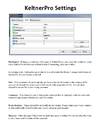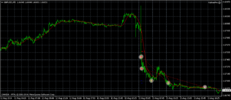took the plunge
I like the way this one trades. Doesn't promise a 95% win rate, but wins twice the size of the losses.
That everybody is consistent on what the trades are gives some confidence. So I'm in.
Thanks all.
Addendum:
Does anybody know what the "risk" parameter keys off of in calculating trade sizes? The documentation is inconsistent on this point, at one place referencing "balance" and in another "equity". This makes a big difference in an account where the broker has granted you a "trade credit" showing up in equity, but not in the balance. If you have a $5K account balance, and the broker gives you a credit, you can have an equity of $10K, but when your balance draws close to zero, the broker will yank that credit back resulting in a margin call & a busted account. But the idea is you can effectively lose just about your whole balance in floating losses, before that happens. I've emailed support, but not gotten an answer. It appears to me it's keyed off of free margin, because the trade sizes decrease when it fires off multiple trades. So, it looks to be going off of your equity minus whatever margin is being subtracted, so my fears of overleveraging when using 0.1 in such an account could be realized. If you used 0.05 with such an arrangement and a 1:1 bonus, you'd effectively be getting 0.1. Anybody care to comment?
Q. What is a 'credit bonus'?
A. A credit bonus increases account equity, free margin and leverage, but cannot be used to fund trading losses and cannot be withdrawn as cash. By increasing free margin, the actual margin call and stop-out levels are reduced to almost 0% above the account balance, meaning that open losses can almost equal the account balance before stop-out will occur.
https://www.tallinex.com/faq
I like the way this one trades. Doesn't promise a 95% win rate, but wins twice the size of the losses.
That everybody is consistent on what the trades are gives some confidence. So I'm in.
Thanks all.
Addendum:
Does anybody know what the "risk" parameter keys off of in calculating trade sizes? The documentation is inconsistent on this point, at one place referencing "balance" and in another "equity". This makes a big difference in an account where the broker has granted you a "trade credit" showing up in equity, but not in the balance. If you have a $5K account balance, and the broker gives you a credit, you can have an equity of $10K, but when your balance draws close to zero, the broker will yank that credit back resulting in a margin call & a busted account. But the idea is you can effectively lose just about your whole balance in floating losses, before that happens. I've emailed support, but not gotten an answer. It appears to me it's keyed off of free margin, because the trade sizes decrease when it fires off multiple trades. So, it looks to be going off of your equity minus whatever margin is being subtracted, so my fears of overleveraging when using 0.1 in such an account could be realized. If you used 0.05 with such an arrangement and a 1:1 bonus, you'd effectively be getting 0.1. Anybody care to comment?
Q. What is a 'credit bonus'?
A. A credit bonus increases account equity, free margin and leverage, but cannot be used to fund trading losses and cannot be withdrawn as cash. By increasing free margin, the actual margin call and stop-out levels are reduced to almost 0% above the account balance, meaning that open losses can almost equal the account balance before stop-out will occur.
https://www.tallinex.com/faq
Last edited:

